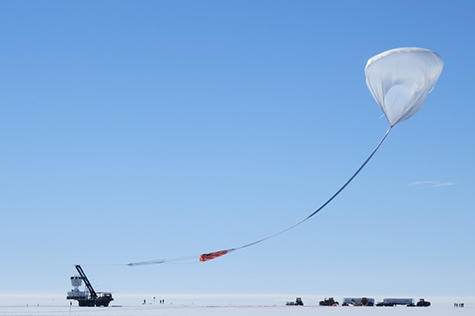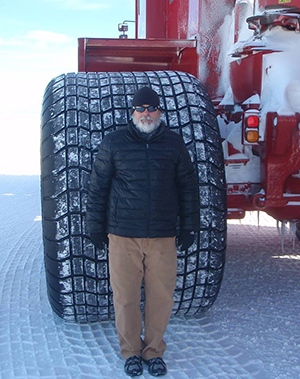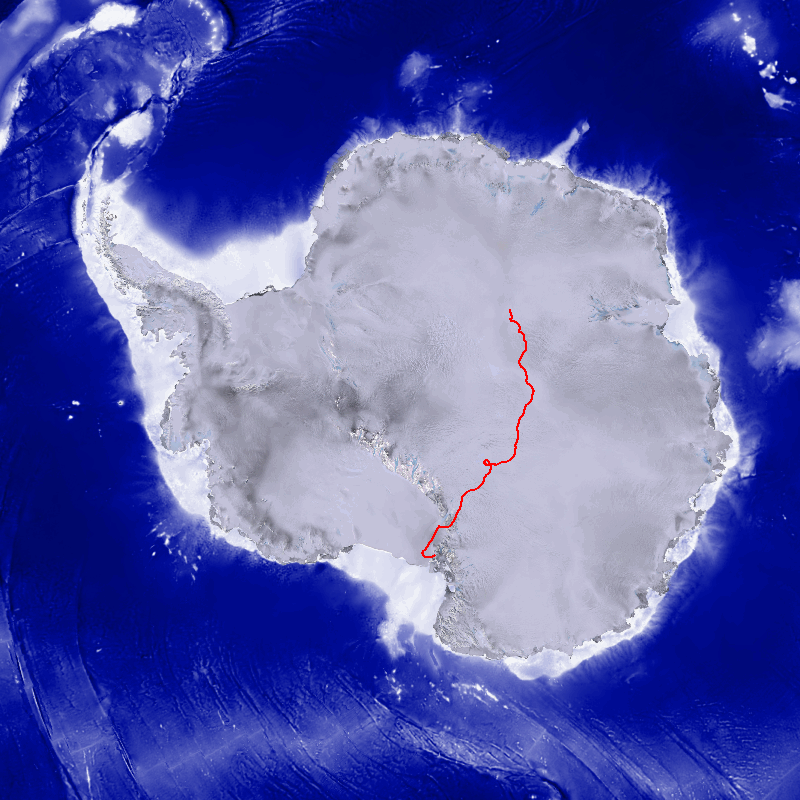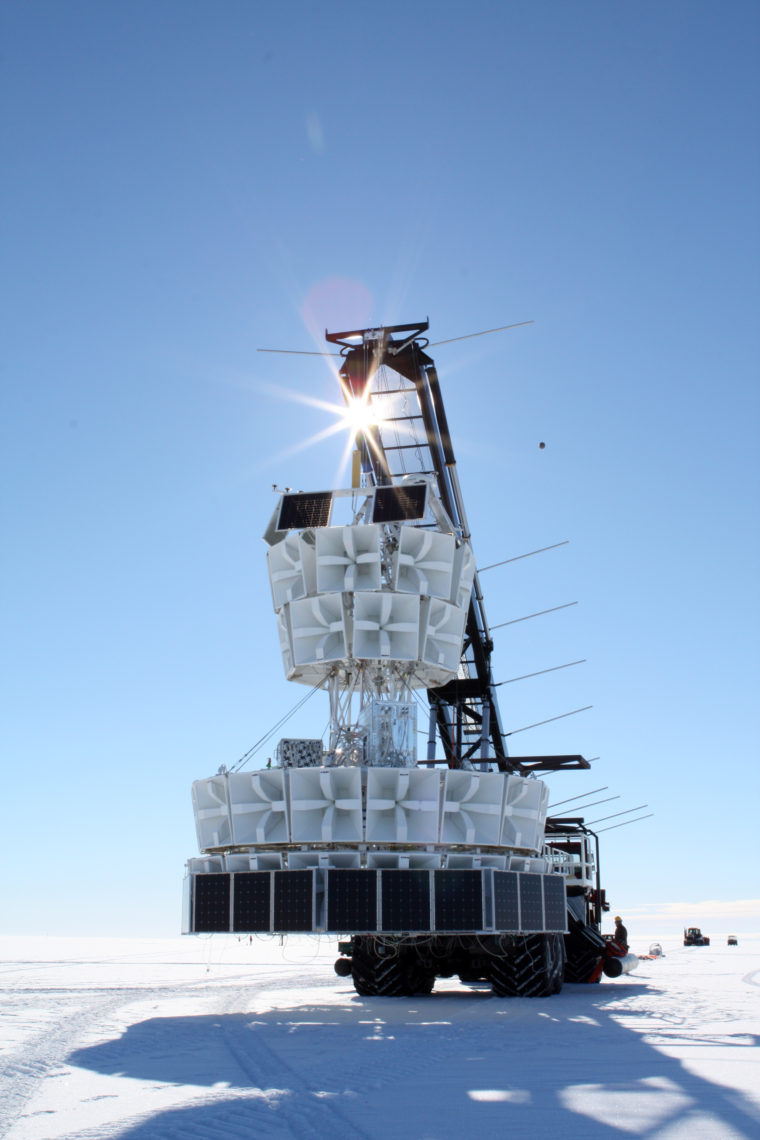On Dec. 17, Martin Israel, PhD, professor of physics at Washington University in St. Louis, emailed to say that the stratospheric balloon carrying ANITA III, a high-energy astrophysics experiment, was about to be released into the polar vortex above Antarctica.
Israel and W. Robert Binns, PhD, research professor of physics at Washington University, had been anxiously monitoring the launch site from St. Louis. Both are co-investigators on the ANITA project, a multi-university consortium led by Peter Gorham of the University of Hawaii-Manoa.
A non-scientist looking at a photo of ANITA might be flummoxed. What could this possibly be? The torch for a cubist Statue of Liberty? A high-concept chandelier? A monster sound system?
Actually any guess having to do with sound would be close. ANITA III consists of 48 horn antennas, flaring metal waveguides that direct sound into a beam, that are listening for short radio bursts generated by the interaction of “hot” particles from outer space with Earth’s atmosphere and the Antarctic ice sheet.
The first incarnation of the instrument, ANITA I, which flew from Antarctica in the austral summer of 2006-2007, was looking for ultra-high-energy neutrinos. “It didn’t see any, but to our complete surprise, it did see 16 ultra-high-energy cosmic rays,” Binns said.
“So the major objective of the project has changed. ANITA III will look for ultra-high-energy cosmic rays, recording neutrinos if it’s lucky enough to see any,” Binns added.
By “high energy,” the scientists mean really high, on the order of 1019 to 1021 electronvolt (eV). For comparison, visible-light photons have energies of 1.5 to 3.5 eV and high-energy X-rays for medical imaging have energies of 2 x 105 eV.
By sampling neutrinos and cosmic rays, the scientists can probe the cosmos in much the same way that astronomers probe the visible universe by sampling light. Neutrinos and cosmic rays just obey different rules and thus reveal other truths.
Into the blue
The Columbia Scientific Balloon Facility (CSBF) team that releases stratospheric balloons in Antarctica waits to launch until conditions are nearly perfect. Before ANITA finally flew Dec. 17, five launch attempts had to be scrubbed because of wind.
Antarctica is the coldest, but also the windiest, continent on the planet. “To launch a balloon the surface winds have to be below about 8 knots, which is about 9 miles an hour,” said Binns, the veteran of many balloon campaigns.
“You also have to have low winds up to about 800 feet,” Binns said. “They use a smallweather balloon, called a pi-ball (pilot balloon) to check those. Sometimes those winds will be stiff even if it is calm on the ground. You’ll see the pi-ball go up and then all of a sudden it will take off sideways.”
“When these big stratospheric balloons are launched but not yet fully inflated, they are about 600 feet long. So if they go up and hit wind shear, they can be torn apart,” he said.

Given the constraints of time and weather, every successful launch is a thrill.
Snap, crackle, pop
Why is ANITA listening for radio bursts?
When an ultra-high-energy neutrino interacts with the ice, it produces a giant shower of electrons and positrons, Binns said. The shower in turn creates a radio burst that refracts up through the ice to the air and travels through the air to ANITA’s receivers.
Ultra-high-energy cosmic rays also produce radio bursts, but they interact with Earth’s atmosphere rather than the ice, producing radio bursts that reflect off the ice and up to ANITA.
Radio bursts are generated because the particle showers are traveling faster than the speed of light in the ice or the air.
Missing neutrinos
What motivated the original search for ultra-high-energy neutrinos?
“Because neutrinos don’t interact with much of anything, they let us see far, far away,” Israel said. “Any other type of radiation is limited by one thing or another, but with neutrinos we could probe the whole universe.”
“So that’s one thing that makes them interesting They provide a window on the entire universe,” he said. “But the second reason we went looking for neutrinos is we knew they had to be there.
“We know that, at least in our cosmic neighborhood, we know there’s a steep drop in cosmic rays with energies above 5 x 1019 eV,” Israel continued. “That’s called the GZK cut-off and it’s there because cosmic rays with higher energies interact with the cosmic microwave background (the thermal radiation left over from the Big Bang) and lose enough energy that they don’t reach Earth.
“But the interactions between these ultra-high-energy cosmic rays and the microwave background produce ultra-high-energy neutrinos. So the neutrinos have to be there,” Israel said.

But the first two ANITA flights didn’t see any ultra-high-energy neutrinos. If they’re “guaranteed,” why weren’t they there?
“I tell people they’re guaranteed, but you have to read the fine print,” Binns said.
“They’re guaranteed if most of the ultra-high-energy cosmic rays are protons, but if they’re heavier nuclei, it turns out that you don’t see the neutrinos. That’s beginning to look likely,” said Binns, “although nobody knows for sure.”
“Another possibility is that we’re wrong about the interaction cross section of the neutrinos,” Israel said, “that is, the probability that they’ll interact with the ice.
“What is the interaction probability for a 1020 eV neutrino in the ice?
It’s not something we’ve ever checked in an accelerator because we don’t make 1020 eV anything in accelerators, so it involves some theoretical calculations—which are reasonably well understood but includes uncertainties,” Israel said.
The early calculations of the interaction cross section, in other words, may have been too optimistic.
The lady and the tiger
As it happens, Washington University’s Cosmic Ray Group has a second team on the ice waiting to retrieve Super-TIGER, a balloon-borne cosmic-ray experiment that was brought down in West Antarctica, about 200 miles from the Transantarctic Mountains, two years ago.
Both ANITA and Super-TIGER are designed to detect cosmic rays, a catch-all term for the immensely energetic nuclei of atoms that have been stripped of their electrons by violent cosmic processes.
Super-TIGER, however, collected cosmic rays with energies of about 109 or 1010 eV, a hundred million times lower than the energies of the particles ANITA seeks.
The enormous difference in energy implies a different generation mechanism, Binns said. “We believe the particles Super-TIGER detected were generated in our galaxy, whereas the ultra-high-energy ones ANITA is looking for come from outside the galaxy.

“We’re pretty sure those in our galaxy were accelerated by shockwaves from supernovae explosions,” Binns said. “Nobody really knows how the ultra-high-energy cosmic rays are generated.”
Because cosmic rays are charged particles, they are deflected by the magnetic fields that thread the galaxy and the universe, making it impossible to trace them back to their source.
But, Israel said, a cosmic ray with an energy of 1020 eV or more might fly straight. The only problem is that there’s only one of those per square kilometer per century, he said.
“But from balloon altitude, ANITA’s radio receivers are looking at roughly a million square kilometers of ice. We have such a big detector, we will get to see these rare events,” Israel said.
In addition to University of Hawaii and Washington University, the other institutions participating in ANITA are: the University of Delaware, Ohio State University, the University of Chicago, Kansas University, the University of California-Los Angeles, the Jet Propulsion Laboratory, University College in London, and the National Taiwan University
